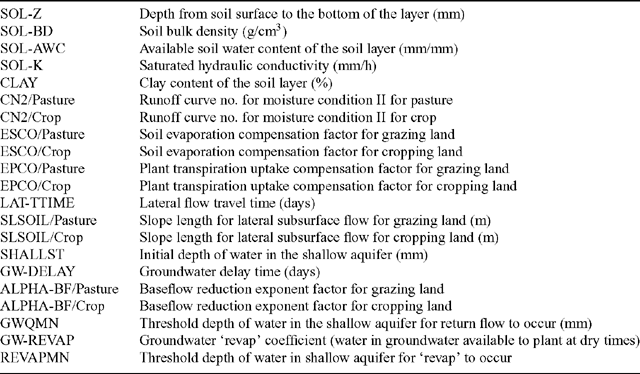A catchment-based approach to recharge estimation in the Liverpool Plains, NSW, Australia
H. Sun A B and P. S. Cornish AA University of Western Sydney, Hawkesbury, NSW 1797, Australia.
B Corresponding author; present address: Infrastructure Planning Branch, Water Corporation, 629 Newcastle Street, Leederville, WA 6007, Australia. Email: hua.sun@watercorporation.com.au
Australian Journal of Agricultural Research 57(3) 309-320 https://doi.org/10.1071/AR04015
Submitted: 23 January 2004 Accepted: 1 August 2005 Published: 31 March 2006
Abstract
This study investigated drainage and shallow groundwater change in a headwater catchment of the Liverpool Plains in north-western New South Wales. A catchment model, SWAT (Soil and Water Assessment Tool), was used to explore rain-fed drainage to shallow groundwater and its relationship to land use. Drainage was predicted along with the prediction of runoff on a catchment and land-use basis over a simulation period of 44 years. Predicted drainage in the catchment was 8 mm/year for the 44 years, which essentially matched estimates derived from bore data observed in the catchment over a 22-year period. These estimates of drainage are much lower than published estimates based on scaling up to the catchment using estimates of drainage derived from point-scale models for different land uses. Estimates of drainage for the different land uses, derived from the catchment model, were also generally lower than simulated drainages from other studies in the area using point-scale models.
The investigation demonstrates a place for catchment-based modelling for estimating drainage at the catchment scale. This is mainly because observed catchment runoff is used as an error controller in catchment recharge modelling, whereas scaled-up point-scale modelling generally does not use observed catchment runoff to derive the catchment drainage. Modelling on the Liverpool Plains catchment also suggests that some of the drainage entering the vadose zone and groundwater is later lost via evapotranspiration, a process not generally simulated in crop models, and requiring further investigation to improve understanding of recharge processes and accuracy of modelling.
Additional keywords: SWAT, crop.
Acknowledgments
This study was jointly funded by the Grains Research and Development Corporation and the University of Western Sydney (UWS). We thank Messrs Tim Watts, Brian Parsons, Andrew Cutler, Gary Coady, Warwick Mawhinney, and Will Dorrington of the Department of Infrastructure, Planning and Natural Resources, NSW, for assisting with data acquisition and project development. We thank Patrick Hanson of UWS for assisting with instrumentation.
Abbs K, Littleboy MW
(1998) Recharge estimation for the Liverpool Plains. Australian Journal of Soil Research 36, 335–357.
| Crossref | GoogleScholarGoogle Scholar |

Arnold JG,
Alen PM, Bernhardt G
(1993) A comprehensive surface-groundwater flow model. Journal of Hydrology 142, 47–69.
| Crossref | GoogleScholarGoogle Scholar |

Arnold, JG ,
Williams, JR ,
Nicks, AD ,
and
Sammons, NB (1990).
Banks, RG (1998). ‘Soil landscapes of the Blackville 1 : 100 000 sheet.’ (Dept Land & Water Conservation, Gunnedah Research Station: Gunnedah, NSW)
Baron BC, Pilgrim DH, Cordery I
(1980) Hydrological relationships between small and large catchments. Research Project 75/80, Australian Water Resources Council, Technical paper No.54.
Broughton A
(1994) Mooki River catchment hydrogeological investigation and dryland salinity studies. Dept Land & Water Conservation, Report TS 94.2.
Daniel JF
(1976) Estimating ground water evapotranspiration from stream flow records. Water Resources Research 12, 360–364.

DIPNR (2001). ‘Runoff data for Warrah Ridge.’
(Department of Infrastructure, Planning and Natural Resources: Gunnedah, NSW)
Freebairn DM,
Silburn DM, Loch RJ
(1989) Evaluation of three soil erosion models for clay soils. Australian Journal of Soil Research 27, 199–211.
| Crossref | GoogleScholarGoogle Scholar |

Greiner R
(1997) Integrated catchment management for dryland salinity control in the Liverpool Plains catchment: a preliminary study from an economic perspective. Research Report. LWRRDC, Canberra.
Holland JF, Doyle AD, Marley JM
(1987) Tillage practices for crop production in the summer rainfall areas. ‘Tillage—new directions in Australian agriculture’. Ch. 3. (Eds PS Cornish, JE Pratley)
pp. 48–71. (Australian Society of Agriculture/Inkata Press: Melbourne, Vic.)
Knisel WG
(1980) CREAMS, a field scale model for chemicals, runoff and erosion from agricultural management systems. USDA Conservation Research Report No.26.
Leonard RA,
Knisel WG, Still DA
(1987) GLEAMS: Groundwater loading effects of agricultural management systems. Transactions of the American Society of Agricultural Engineers 30, 1403–1418.

Maidment, DR (Ed.-in-Chief) (1993).
Meinzer OE, Stearns ND
(1927) A study of groundwater in the Pomperaug Basin, Connecticut. U.S. Geological Survey Water-Supply Paper 2309.
Neitsch, SL ,
Arnold, JG ,
and
Williams, JR (2001).
Rasmussen WC, Andreasen GE
(1959) Hydrologic budget of the Beaverdam Creek Basin, Maryland. U.1472.
Ringrose-Voase A, Cresswell H
(2000) Measurement and prediction of deep recharge under current and alternative farming practice. Report CDS 16, CSIRO Land and Water.
Siberstein R, Vertessy R, Stirzaker R
(2002) The basics of catchment hydrology. ‘Trees, water and salt—an Australia guide to using trees for healthy catchments and productive farms’. Joint Venture Agroforestry Program. (Eds R Stirzaker, R Vertessy, A Sarre)
pp. 11–25. (RIRDC: Australia)
Sun H, Cornish PS
(2003) Modelling water quality in the Liverpool Plains. ‘National Conference on Integrated Catchment Management, Nov. 2003’. (Australian Water Association, NSW Branch: Parramatta, NSW)
Sun H, Cornish PS
(2005) Estimating shallow groundwater recharge in the headwaters of the Liverpool Plains using SWAT. Hydrological Processes 19,
| Crossref |

Timms W,
Acworth RI, Berhane D
(2001) Shallow groundwater dynamics in smectite dominated clay on the Liverpool Plains of New South Wales. Australian Journal of Soil Research 39, 203–218.
| Crossref | GoogleScholarGoogle Scholar |

Tschinkel HM
(1963) Short term fluctuation in streamflow as related to evaporation and transpiration. Journal of Geophysical Research 68, 6459–6469.

USDA Soil Conservation Service (1972).
Williams JR,
Jones CA, Dyke PT
(1984) A modeling approach to determining the relationship between erosion and soil productivity. Transactions of the American Society of Agricultural Engineers 27, 129–144.

Williams JR,
Nicks AD, Arnold JG
(1985) Simulator for water resources in rural basins. Journal of Hydraulic Engineering 111, 970–986.

Young R, Ringrose-Voase A, Bernardi T
(2003) Achieving upper limits of seasonal extraction may not provide a significant buffer against deep recharge in vertosols. ‘GRDC Water Balance Workshop’. Canberra, 12–13 Feb. (GRDC: Canberra, ACT)

|


